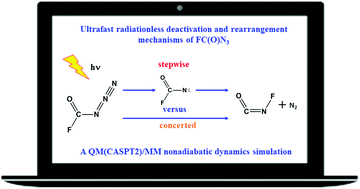Photoinduced Curtius rearrangements of fluorocarbonyl azide, FC(O)N3: a QM/MM nonadiabatic dynamics simulation†
Abstract
Upon either photolysis or pyrolysis, carbonyl azide can eliminate molecular nitrogen along with the formation of isocyanate. Though two different pathways (namely stepwise versus concerted) have been proposed, the detailed decomposition mechanism is still elusive to date. Herein, we have employed combined electronic structure calculations and nonadiabatic dynamics simulations to study the radiationless deactivation and rearrangement mechanisms of FC(O)N3 in the S3, S2, S1, and S0 states in an argon matrix. On the basis of QM(CASPT2)/MM calculations, we found that, upon 193 nm irradiation, the excited-state decay of FC(O)N3 from the S3 state via S2 and S1 to the S0 state is an ultrafast process and could be completed within 100 fs, and a subsequent Curtius rearrangement occurs in the period of ∼300 fs; the elimination of N2 and the formation of fluorocarbonyl nitrene FC(O)N could take place in both S1 and S0 states rather than in higher excited states; the isomerization from FC(O)N to FNCO involves a stepwise mechanism and could only be found in the S0 state. This mechanistic scenario has been verified by both electronic structure calculations and full-dimensional trajectory-based “on the fly” QM(CASPT2)/MM nonadiabatic dynamics simulations. Finally, the currently calculated results provide important mechanistic insights for similar carbonyl azides.

- This article is part of the themed collection: 2018 PCCP HOT Articles


 Please wait while we load your content...
Please wait while we load your content...